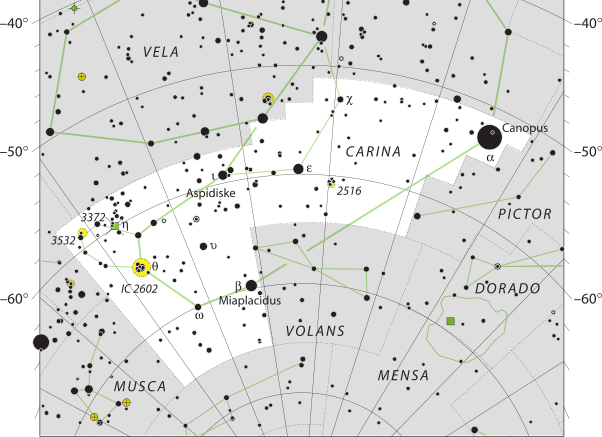Located in the southern sky, the constellation Carina is Latin for the hull or keel of a ship. Carina is named after parts of a ship because it was the southern foundation of the larger constellation of Argo Navis until it was divided into three pieces. The other 2 constellations of Argo Narvis was Puppis and Vela.
Carina is in the southern sky quite near the south celestial pole, making it circumpolar for most of the southern hemisphere. By the year 4700, the Earths southern celestial pole will be in Carina.
| Applicable Information | |
| Visibility In Pacific Northwest | Only Partially Visible From December to March |
| Best Times To View | March |
| Right Ascension | 06h 02m 59.7365s–11h 20m 37.4211s |
| Declination | −50.7545471°–−75.6840134° |
| Area | 494 square degrees |
| Main Stars | 9 |
| Brightest Object | Canopus |
| Meteor showers | Alpha Carinids, Eta Carinids |
| Messier objects | 0 |
| Neighboring Constellations | Vela, Puppis, Pictor, Volans, Chamaeleon, Musca, Centaurus |
History
Carina was once a part of Argo Navis, the great ship of Jason and the Argonauts who searched for the Golden Fleece. The constellation of Argo was introduced in ancient Greece and was divided into 3 constellations in 176 by Nicolas Louis de Lacaille.
Observers in Northern China can barely see the stars of Carina. The star Canopus, which is the south polar star in Chinese astronomy, was located by Chinese astronomers in the Vermilion Bird of the South. The remaining stars were classified by Xu Guanggi during the Ming Dynasty, based on the knowledge acquired from western star charts.
Stars
There are several other stars above magnitude 3 in Carina. Eta Carinae is the most prominent variable star in Carina.
The supergiant star Canopus is the 2nd brightest star in the night sky with a magnitude of −0.72 can be found in the constellations borders.
Discovered by French astronomer Nicolas Louis de Lacaille in 1751, NGC 3372, otherwise known as the Carina Nebula, is an emission nebula that has vast star-forming areas. It has a magnitude of 8.0 and an apparent diameter of over 2 degrees. The Keyhole Nebula was discovered in 1847 by John Herschel, and is the central region oof the Carina Nebula. The Keyhole is several light-years wide and is composed mostly of ionized hydrogen, with two major star-forming regions.
The Homunculus Nebula is a planetary nebula visible to the naked eye, which is notable for its ejection luminous blue variable star Eta Carinae.
Eta Carinae is so massive that it has reached the theoretical upper limit for the mass of a star and is therefore unstable. Eta Carinae is considered a prime supernova candidate for the next several hundred thousand years because it has reached the end of its estimated million-year life span.
NGC 2516 is an open cluster is 1/2 a square degree, is visible to the unaided eye, and is approximately 80 stars.
NGC 3114 is an open cluster similar to NGC 2516, but is looser and dimmer as the brightest stars are only 6th magnitude.
The most prominent open cluster is IC 2602, also known as the “Southern Pleiades.” The cluster is home to 60 stars, including Theta Carinae and several other stars that are visible to the unaided eye.
NGC 3532 is an open cluster that is visible to the unaided eye, with a total of 150 stars arranged in an unusual shape.
Carina also contains the globular cluster NGC 2808, which can be viewed by the naked eye. Using small telescopes, observers can see the double stars Epsilon Carinae and Upsilon Carinae.
1E 0657-56 is a galaxy cluster, nicknamed the Bullet Cluster, which is named for the shock wave that resembles the shock wave of a supersonic bullet.
Make sure to check out other articles on the site, including a brief introduction to constellations, other constellation articles, and more!

Thanks for sharing. I read many of your blog posts, and your blog is very good.